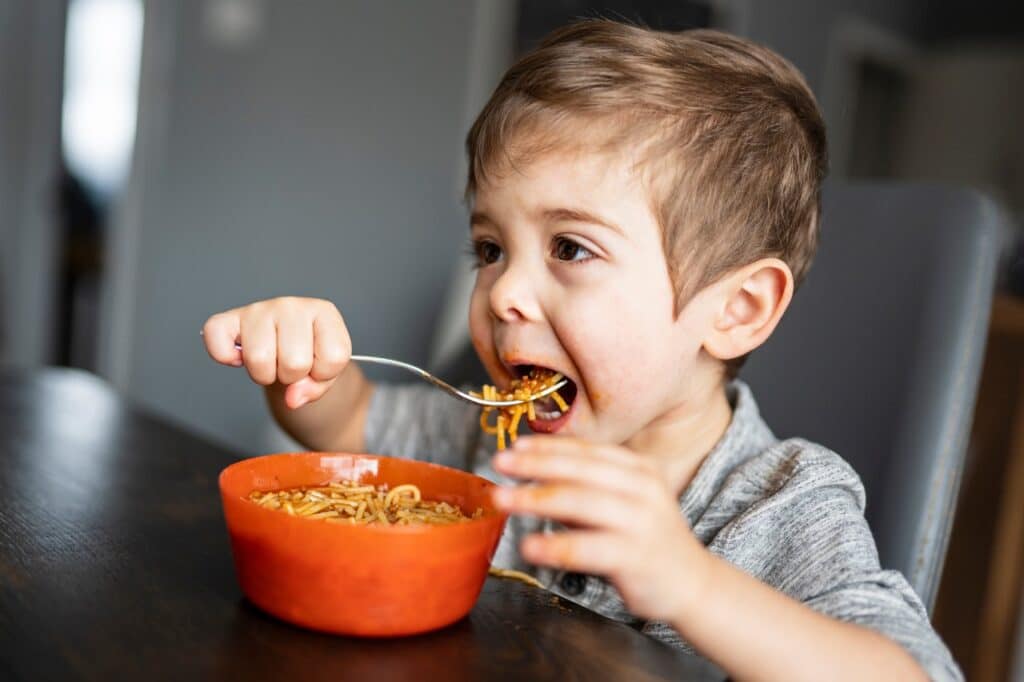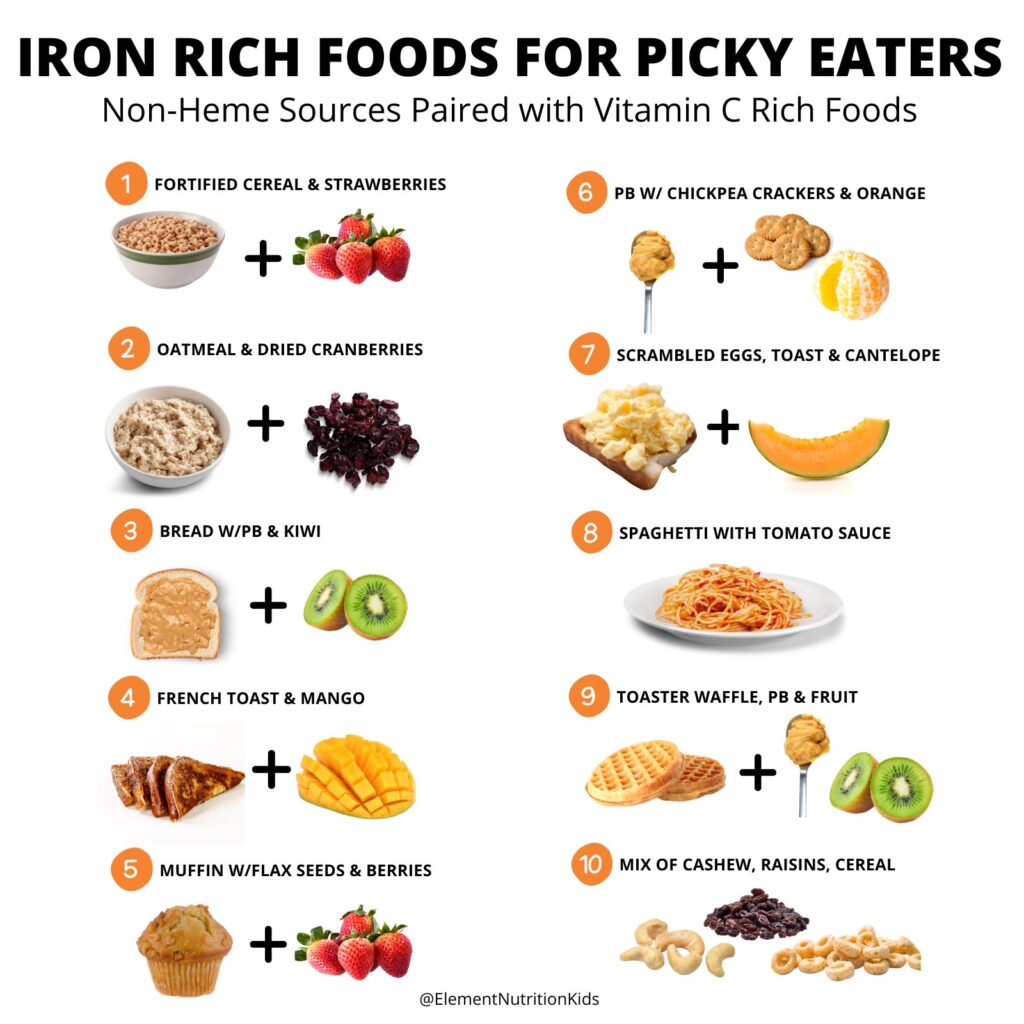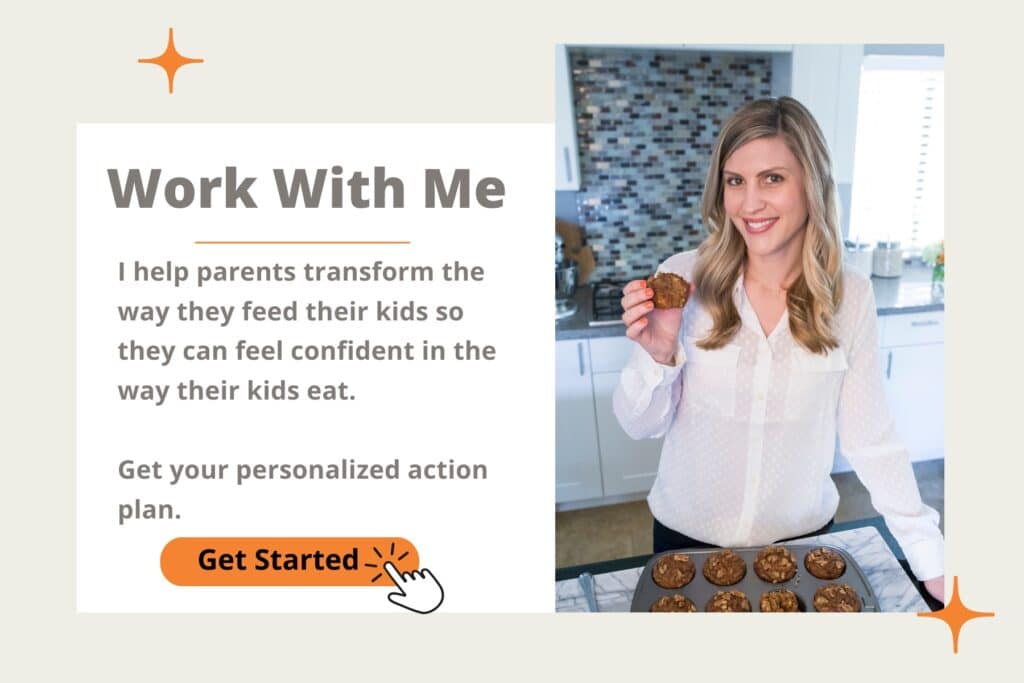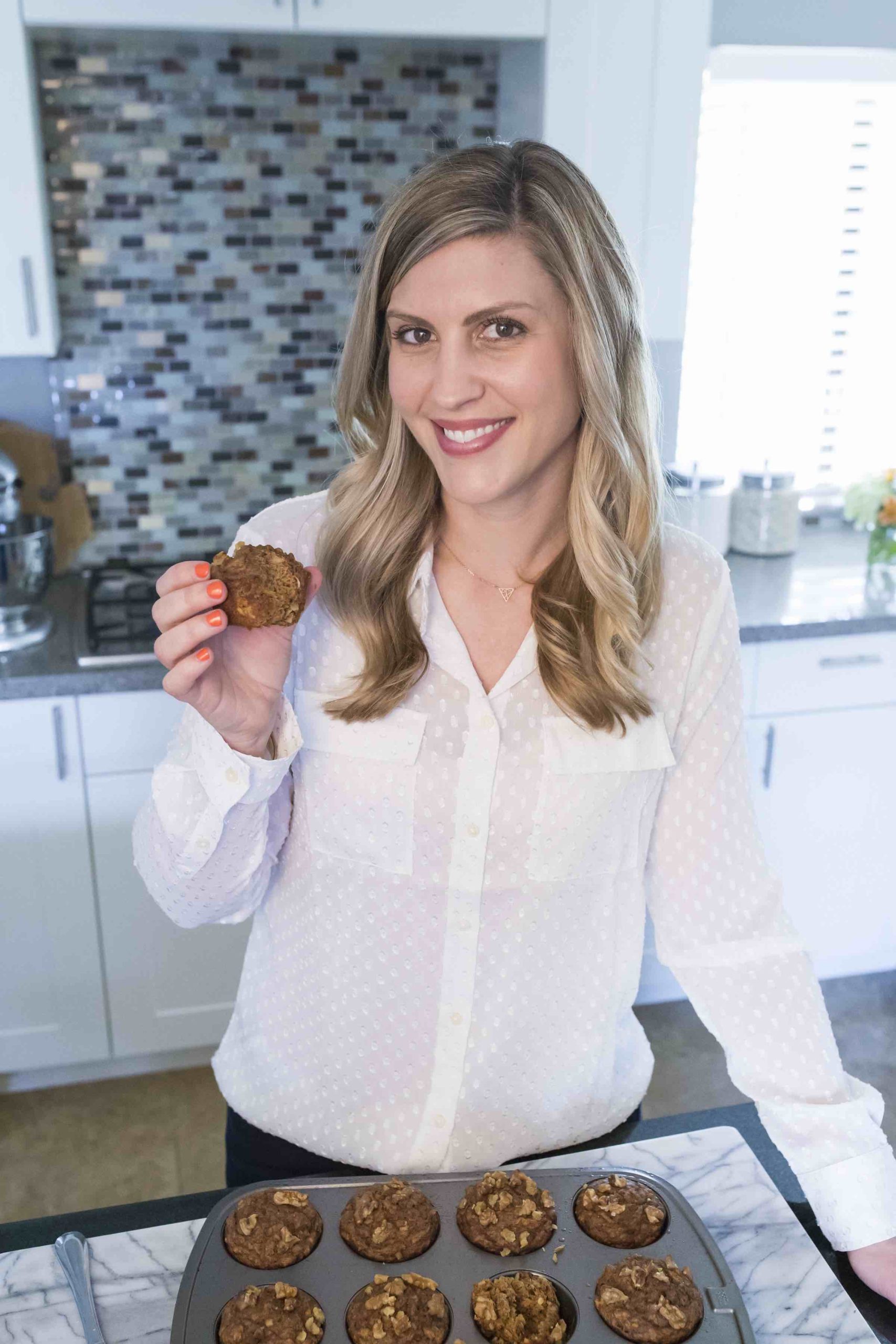Iron deficiency is one of the most common nutrient deficiencies in kids. Picky eaters, especially those who refuse whole food groups (like meat, beans and legumes) are at higher risk for low iron. Because of this, focusing on other sources of iron-rich foods for picky eaters is key.
In this post, I will review the importance of an iron-rich diet for growing babies, toddlers, and kids, and ways parents can encourage intake, especially if they have a picky eater.
*This post was originally published on 8/21/2019 and has been fully updated and revised.

Please note that I am an affiliate for some of the linked products. If you click my affiliate link and make a purchase, I may earn a percentage of the sale at no extra cost to you. As an Amazon Associate, I earn from qualifying purchases.
Table of Contents
Iron needs for babies, toddlers & kids
Iron is one of the top nutrients needed for growing babies, toddlers, and kids. It is a mineral found naturally in food and in foods that are fortified such as bread, pasta, cereal, oatmeal, and infant formulas.
Iron is important for many different reasons as children grow. In babies, rapid growth and brain development are two of the biggest factors for the large jump in iron needs around 7 months. When growth starts to slow in toddlerhood, iron requirements drop, until the next phase of growth which occurs around preschool age.
| Age | Iron Need (7) |
| 0-6 months | 0.27 mg |
| 7-12 months | 11 mg |
| 1-3 years | 7 mg |
| 4-8 years | 10 mg |
Iron deficiency in kids
Anemia related to iron is the most common childhood nutritional deficiency worldwide. Therefore, iron is an essential nutrient to include in your child’s diet.
A diet that lacks iron can lead to iron deficiency or more severe iron-deficiency anemia. When the body doesn’t have enough iron, it cannot make a protein in the blood called hemoglobin. Hemoglobin is needed to transport oxygen throughout the body. Oxygen is needed for the body to function properly.
Children with untreated iron deficiency are at increased risk for problems with neurocognitive development and immune function later in life. Therefore, preventing or reversing iron deficiency quickly is critical.
Causes of iron deficiency in kids
Iron deficiency anemia happens when there isn’t enough iron in the blood. This is generally due to the increased iron needs for growth paired with a lack of iron in the diet. Picky eaters, especially those who don’t eat meat, beans, and legumes, may have a higher risk for iron deficiency if they don’t get enough iron from other foods.
Other reasons for low iron include Malabsorption conditions such as celiac disease, Crohn’s, and ulcerative colitis which interfere with the gut microbiome and damage the lining of the GI tract increasing the risk for iron deficiency.
Following a vegan diet, that is not well planned may also increase the risk of iron deficiency. Vegetarian diets pose a risk if iron-rich plant sources are not included. If you plan to raise your child on a vegetarian or vegan diet, they must have a good mix of plant-based iron sources paired with vitamin C each day.

How do I know if my child is iron deficient?
If your child is deficient in iron, there may or may not be physical symptoms. This can be tricky because when symptoms appear, low iron levels have likely already been an issue for a while.
The easiest way to look at iron levels is by checking hemoglobin. This is an easy test that can be done in the pediatrician’s office with a simple finger prick test. However, hemoglobin isn’t a great indicator of overall iron level because by the time hemoglobin is registered as “low,” the body has likely already had low iron levels for quite some time.
The body fights hard to send iron where it is needed most (the blood), so it starts by pulling iron from its iron stores when the body’s levels drop. Even though the brain needs iron for development (especially important in the first several years of life) iron in the blood is prioritized. Therefore, hemoglobin in the blood can appear normal even when the body’s iron stores are being depleted.
The best way to fully check iron levels is by doing a full iron blood panel (which requires a blood draw.) This can be challenging for kids! The iron panel usually includes ferritin, iron and transferrin saturation, hemoglobin, and hematocrit levels. Ferritin is particularly helpful in identifying overall iron status because it is typically the first iron marker to drop when iron stores are getting low.
What are normal iron levels?
When the pediatrician checks your child’s iron (via finger prick) in the office, they are looking at the hemoglobin levels. The “normal” range varies by age. If your child falls below the bottom end of the range, the doctor will usually recommend a full iron panel be done. This is recommended to rule out any other potential cause of the anemia other than iron.
Again, hemoglobin levels alone are not the best indicator of iron status because they are the last levels to drop when iron is low.
| Age | Hemoglobin Level (g/dl) |
| 6-12 months | 11.3-15.0 |
| 1-5 years | 10.9-15.0 |
| 5-11 years | 11.9-15.0 |
Signs of iron deficiency in kids
Most of the time, you won’t be able to see that your child is low in iron until they have an iron deficiency. Unfortunately, this also means that they have likely had low iron for quite some time before signs appeared. This is why I recommend all parents be proactive and focus on iron-rich foods, especially with picky eaters.
These are a few signs/symptoms of iron deficiency:
- Low hemoglobin (fingerstick is done at the doctor’s office)
- Not growing normally
- Motor and cognitive impairments
- Pica (a condition where they crave non-food items such as rocks, ice, clay, etc.)
- Thin sparse hair
- Fatigue
- Paleness
- Redness, swelling cracking at corners of the mouth
- Sore swollen, red tongue
- Spoon shaped nails
If your child’s doctor identifies that your child has iron deficiency or low iron, starting a supplement is important. Your child can not get enough iron from diet alone to correct a deficiency.
Other causes of anemia in kids
Although iron is the top cause of anemia, it is important to know that there are causes of anemia that are independent of iron intake, such as B12 deficiency. This isn’t super common in babies and children, but it can happen. B12 deficiency is more common in babies and kids following a vegetarian or vegan diet which is naturally lower in B12. Mothers following a vegan diet who are breastfeeding should be supplementing with B12.
The primary reason the pediatrician may order a full blood panel after seeing a low hemoglobin level is to rule out B12 deficiency as the cause of the anemia. If iron supplementation is started but the cause of the anemia is actually related to a B12 deficiency, the true issue could be hidden behind the extra iron and the B12 deficiency would continue.
Thalassemia, an inherited blood disorder also leads to anemia, however, I won’t cover that in this post as this is not common.
Iron deficiency in picky eaters
I recently had a mom in my office with a super “picky” little girl who was 3 years old. This little girl was loving her cow’s milk and fruit, but not into many other foods. The mom was pretty stressed out about her weight (she was on the low end of the growth chart) so she was letting her drink a whole lot of milk so she wouldn’t lose weight. Her selective eating also meant she wasn’t eating many iron-rich foods.
Unfortunately, this can be a recipe for disaster when it comes to iron.
Right around the age of 1.5-2 yrs when growth starts to slow, picky eating tendencies begin. This can be challenging for parents, and if you don’t know what to do when your toddler won’t eat what you offer, you may be tempted to let them drink more milk to get in their calories. However, too much milk (calcium) and not enough iron rich foods can lead to low iron levels.
Milk intake and anemia in toddlers/kids
Calcium, another mineral in the body, competes with iron for absorption. Kids who are not eating enough iron-rich foods and drink large amounts of milk (which is high in calcium) have a higher risk of developing anemia. I recommend 12-16 oz (max) of milk/milk alternatives on a daily basis to help minimize risk of anemia in picky eaters.
I like to work with my clients to get their toddlers down to drinking around 4 oz. max of milk per serving if they are drinking it multiple times per day. It’s also best to move all milk intake to mealtimes and not offer between meals. Toddlers who consistently drink 24 oz. of milk or more per day are at higher risk of developing anemia. This often occurs during the transition time when weaning off formula in young toddlers.
Too much milk (which contains calcium) interferes with iron absorption. When they are drinking that much milk they are getting full of milk and usually not eating enough of other foods, especially ones that contain iron.
Best iron-rich foods for kids
The best iron-rich foods for kids are whole food sources, however, sometimes these are harder to get into picky eaters. If you have a picky eater, start by focusing on the iron-rich food sources they like, while you work on introducing new items. Children need iron-rich foods on a daily basis.
There are two primary iron sources found in food, heme iron, which is found in animal products such as meats and seafood, and non-heme iron, which is found in plant-based and fortified iron sources.
Heme iron is more bioavailable, meaning it is more easily absorbed by the body than plant-based iron. About 25-30% of the heme iron you eat is absorbed. Plant-based iron is absorbed around 2-10%, however, plant-based iron can be absorbed significantly better when it is paired with vitamin C-rich food sources (see examples of each below.)

Heme iron sources
- Meat
- Liver
- Beef
- Ham
- Turkey
- Chicken
- Pork
- Eggs (primarily in the yolk)
- Seafood
- Shrimp
- Clams
- Scallops
- Tuna
- Sardines
- Haddock
- Mackerel
Non-heme food sources
- Eggs (mostly the yolk)
- Spinach
- Sweet potato
- Peas
- Broccoli
- String Beans
- Dandelion Greens
- Collard Greens
- Kale
- Chard
- Strawberries
- Watermelon
- Raisins
- Dates
- Figs
- Prunes/prune juice
- Dried apricots
- Fortified bread
- Enriched pasta
- Fortified baby cereals
- Cream of wheat
- Bran cereal
- Oat cereal
- Rye bread
- Enriched Rice
- Legume pasta
- Tofu
- Beans (kidney, garbanzo, white beans)
- Peas
- Lentils
- Molasses
Vitamin C-rich food sources
Adding vitamin C-rich foods to iron-rich foods improves their absorption rate (this is especially important for non-heme iron sources, including fortified foods.)
- Strawberries
- Citrus fruits (lemon, lime, grapefruit, oranges)
- Kiwi
- Papaya
- Guava
- Tomato (including tomato sauces)
Iron-rich foods comparison chart (commonly consumed kids’ foods)
| Food Item | Iron Source | Iron Content |
| Beef (3 oz) | Heme | 2.2 mg |
| Chicken (3 oz) | Heme | 1.2 mg |
| Chicken Nuggets (4 each) | Heme | 0.8 mg |
| Shrimp (3 oz) | Heme | 0.3 mg |
| Egg (1) | Non-Heme | 0.6 mg |
| O’s Cereal (1 cup) | Non-Heme | 10.2 mg |
| Oatmeal (1 cup) | Non-Heme | 13.9 mg |
| Whole Wheat Bread (1 slice) | Non-Heme | 0.7 mg |
| Peanut Butter (1 Tbsp) | Non-Heme | 0.3 mg |
| Almond Butter (1 Tbsp) | Non-Heme | 0.6 mg |
| Hemp Seeds (1 Tbsp) | Non-Heme | 2.4 mg |
| Flax Seeds (1 Tbsp) | Non-Heme | 0.6 mg |
| Cooked pasta (macaroni) (1 c) | Non-Heme | 1.86 mg |
| Raisins (¼ c) | Non-Heme | 0.68 mg |
Remember that heme iron sources are absorbed more efficiently, however, non-heme sources make up a larger portion of the diet. Consuming adequate vitamin C-rich foods can improve the absorption rate of non-heme sources. Below is a list of ideas for ways you can pair commonly consumed iron-rich foods for picky eaters with vitamin C rich foods.

10 Iron-rich foods for picky eaters
If you have a picky eater at home struggling with some of the more common “iron-rich foods” like meat, beans, and legumes, you’re not alone! Many picky eaters often refuse meat, it can have a tough texture. If you struggle with a picky eater, meet them where they are while you work on changes. Many traditional breakfast foods are great for picky eaters (toddlers & kids).
These are some of my favorite iron-rich foods for picky eaters that are commonly accepted. Pairing these foods with vitamin C-rich foods will help the body absorb more of the iron.
- Iron-fortified breakfast cereals (cold or hot) (I like to aim for whole grain cereals with a minimum of 2 g fiber, 2+ g protein, and <6-7 g of added sugar per serving, with a max of 9 g added sugar.) Oatmeal, wheat farina, cream of wheat). Again, getting plain versions is best and then you can self-sweeten as needed with things like maple syrup, honey, and fresh or dried fruit.
- Whole-grain bread (which is also fortified with iron.) Bread is great for toast, sandwiches, or French toast.
- French toast (made with fortified whole grain bread, eggs, cinnamon.) Easy recipe linked. Great served with strawberries!
- Whole grain toaster waffles with peanut butter (I love Kodiak brand, Vans, Kashi, and even Trader joes whole grain waffles)
- Muffins made with seeds/beans/legumes. This white bean muffin recipe is good, my kids love them.
- Peanut butter (you can add this to so many things, toast/bread, chickpea crackers, smoothies, waffles, etc.)
- Seeds (flax, hemp, and chia seeds) are easy to stir into oatmeal, cereal, muffins, pancakes, etc.)
- Eggs (many picky eaters like some form of eggs.) Scrambled, hard-boiled, or an egg sandwich are all great options.
- Pasta (especially whole grain pasta or legume pasta.) Adding spaghetti sauce (rich in vitamin C) will boost iron absorption.
- Dried Fruits (prunes, apricots, raisins, mango)
- Bonus: Chicken Nuggets (awesome if you can make them homemade, but if not, even the frozen ones have iron.)
Iron-fortified food for kids
Many people question whether iron-fortified foods are good for our bodies. While they are considered safe, they will never be as good as real, whole-food sources of iron.
Fortified food is a food item that does not naturally contain iron but is added to the product during processing. In the 1900s, there were many vitamin and mineral deficiencies in children so the decision was made to fortify foods with key nutrients such as thiamin, niacin, riboflavin, iodine, vitamin D, and iron. These are all key nutrients needed for growth and development in children.
The high rate of vitamin and mineral deficiencies, including iron deficiency, is also one of the main reasons iron-fortified infant cereals were once strongly recommended as a first food for babies.
Unfortunately, we still don’t know a ton about how well the body utilizes the iron in fortified foods. We do know it is less “bioavailable” than iron sources like meats which have a high bioavailability (or ability to be absorbed.)
All that being said, if you have a picky eater who doesn’t eat most of the more bioavailable sources, then your best bet is to focus on the sources they will eat. These are often fortified food products. Getting iron from fortified foods (or supplements) is still better than not getting enough iron at all.
In summary
Iron is a key nutrient for children’s growth and development. However, it can be challenging to get enough iron into kids who are picky eaters. Many picky eaters miss out on whole food groups, such as meats, beans, and legumes. This can lead to low iron intake if they don’t consume enough other foods that contain iron.
The best way to encourage your child to get enough iron in their diet is by providing a variety of iron sources that they are willing to eat each day. Some of the more commonly accepted foods by picky eaters are foods that include fortified grains such as cereals, breads, and pastas.
These fortified foods can help children meet their daily iron needs. However, because they are non-heme sources, they are not as efficiently absorbed. You can improve the absorption of non-heme iron by pairing those foods with foods that are rich in vitamin C.
If your child has a documented iron deficiency, it is important to supplement their diet with iron. Be sure to discuss this with their pediatrician or a pediatric dietitian. Iron-rich foods alone are not enough to correct a diagnosis of anemia.
If you need more help with your picky eater, I’d love to support you. You can book a 1:1 appointment with me and we can review your child’s individual needs.



Thank you so much Jess for this post it really helps!
So glad it was helpful!
Hi! I’m new here to your blog and was wondering if you have a printable chart of iron rich foods? I love all the info.! Thanks =)
Hi Angelica,
I don’t currently have a printable download attached to the post, but am working on adding some new resources this year. If you are on my email list I always send them out there as well as any blog/post updates. Thanks so much for reaching out 🙂